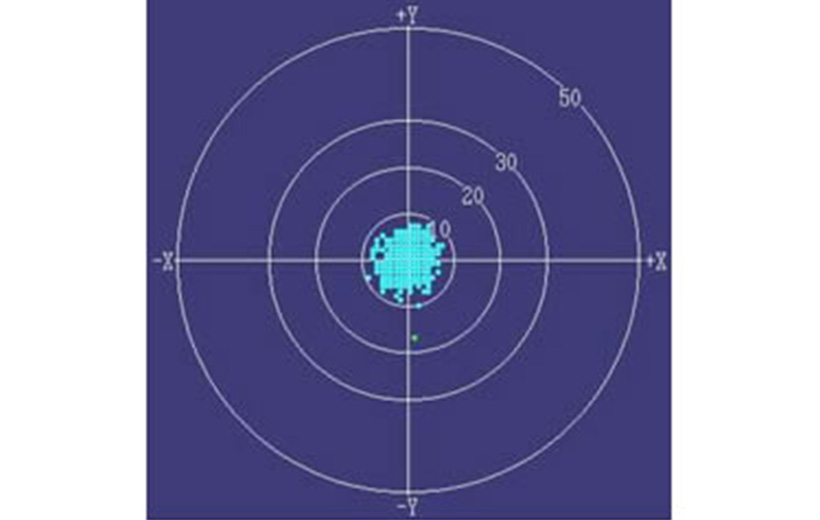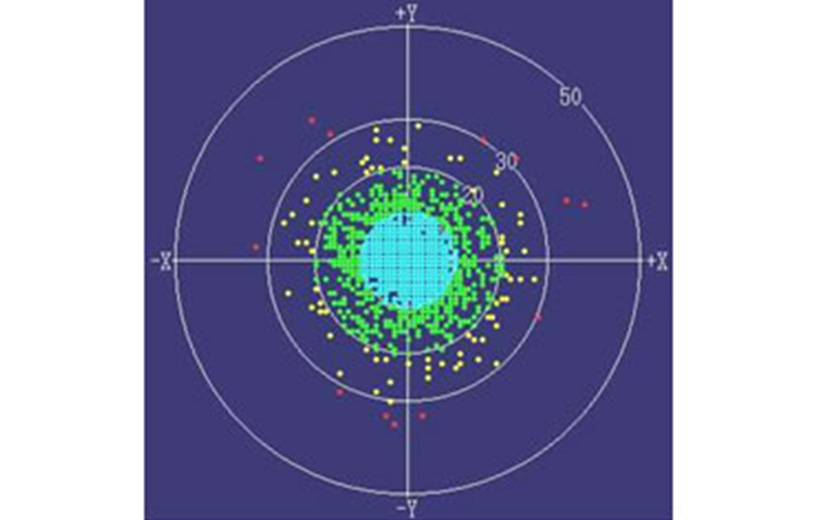Hole registration accuracy is measured by an AOI machine.
Inaccurate hole registration means the situation when hole
registration accuracy does not satisfy a required quality or it becomes unusually worse because of
any troubles.

Normal

Bad
| Cause | Failure condition | Countermeasure |
|---|---|---|
| Poor drill bit strength | Accuracy becomes worse. | To increase strength, change web thickness and web taper. Use the drill bit for superior hole registration accuracy |
| Small chip pocket (Flute volume) | Drill chip pocket is clogged with chip, which worsens accuracy. If chips go between the entry board and PCB, accuracy will worsen notably. | Enlarge chip pocket volume, change web thickness, web taper, and flute land ratio. |
| Long flute length and body length | When flute length and body length are unnecessarily long, the hole registration accuracy worsens. | Set suitable flute length and body length. |
| Unsuitable drill bit geometries (Point Angle and helix angle etc.) | Unsuitable drill bit geometries for the PCB application, drilling conditions, and equipment condition worsen accuracy. | Optimize drill bit geometries, (Select suitable geometries for drilling condition) |
| Unsuitable tungsten carbide material | Increased wearing blunts the drill's cutting edges, causing poor accuracy | Use wear-resistant WC material. |
| Cause | Failure condition | Countermeasure |
|---|---|---|
| Unbalanced drill point geometries (Chisel point inconcentricity, Lip height gap, Chipping, and one sided taper or flare, etc.) | Hole position accuracy gets worse from the upper surface of a PCB. | Check drill point geometry. |
| Unsuitable repointing (See above) | Hole position accuracy gets worse from the upper surface of a PCB. | Check drill point geometry. |
| Cause | Failure condition | Countermeasure |
|---|---|---|
| High chipload | Accuracy is worsened by poor chip evacuation and damaged drill bits etc. | Apply suitable chipload. (Please refer to drilling parameters.) |
| Low chipload | Promotes wearing, causing poor accuracy. | |
| Low spindle speed | Burned swarf will stick to the drill point, and accuracy will worsen. | Apply suitable spindle speed. (Please refer to drilling parameters.) |
| High spindle speed | Tool load increases as cutting resistance increase, making accuracy worse. | |
| Hit count to high | Promotes wearing, causing poor accuracy. | Apply suitable hit counts. |
| To many repoints | It promotes diameter wear, and accuracy will worsen. | Reconsider the number of repoints. |
| Cause | Failure condition | Countermeasure |
|---|---|---|
| Panel stack height to high | Drill deflection will increases in proportion to PCB Stacks, making accuracy worse. | Apply suitable PCB stack heights to achieve the quality target. |
| High number and thickness of PCB copper layers | The increase of cutting resistance causes wear, and worsens accuracy. | Decrease PCB stack heights and hit count to reduce drill bit damage. Use double drilling method. |
| Hard cutting PCB material | The increase of cutting resistance causes wear and chipping, worsening accuracy. | Decrease PCB stack heights and hit count to reduce drill bit damage. |
| Unsuitable entry board | Using low performance entry board on PCB's with high hole qualities may not obtain the accuracy demanded. | Decrease PCB stack heights and hit count to reduce drill bit damage. |
| Scratching and dust on the front side of entry board | Drill bit is deflected by the unevenness of the entry board, worsening accuracy. | Control the management and handling of entry board. Check the bush for defects. |
| Unsuitable backup board | Hard back up board causes wear, which worsens accuracy. | Consider suitable hardness. |
| Unsuitable Stack preparation | Loosely stacked entry board and PCB's (poor PCB stack preparation) causes poor accuracy. | Check stud pins and tapering of the PCB stacking to prevent the entry board flapping and gaps in PCB stack. |
| Uneven and scratched surface on the PCB | Drill bit was deflected by the unevenness and scratching on the front side of entry board, worsening accuracy. | Check PCB quality. |
| PCB qualities | Uneven resin and fiber intersections worsen hole accuracy. | Check PCB quality. Example: Check unevenness of PCB using an image processor/AOI machine for measuring hole registration accuracy. ---> An extreme striped pattern, etc. |
| Cause | Failure condition | Countermeasure |
|---|---|---|
| TIR (Total Indicated Runout) | Large dynamic deflection worsens accuracy. | Control spindle run out (maintenance and repair). Recommended value <10 micron (<5 micron is better for <0.3mm drill bits) |
| Drilling machine's condition | A worn or un-smooth ball screw or linear bearing from constant use worsens accuracy. | Maintain the drilling machine, the checking machine precision, and routine major services |
| Unsuitable Vacuum force | A high vacuum force lifts the entry board allowing chips to go in between the entry board and PCB, causing the drill not to center properly. In the case of low vacuum, it worsens chip evacuation and causes chip clogging. | Set suitable vacuum force. (Recommended value: 0.4dia. 100-150 hPa, 0.1dia. 70-140 hPa) Maintain dust catcher system of the drilling machine. |
| Unsuitable pressure foot force | Low pressure foot force prevents proper clamping of the bush to the entry board, causing chip clogging and poor accuracy. | Set correct pressure foot force. (Recommend: About 100-150 N, Suitable value is depends on application) |
| Unsuitable bush diameter | A large diameter bush prevents good chip evacuation and worsens accuracy. | Using small inner diameter bush. Example: Change from 10mm to 3mm inner dia. |
| Uneven contact of bush with entry board | Uneven bush contact, a damaged bush or poor surface condition of the bush contact area causes poor accuracy. | Check whether pressure foot is parallel with the machine table. Check bush contact using PV-Checker. (Recommendation: Over 80% surface touching bush) |
PRODUCT 01 PCB Drills / Routers / Ultra precision micro-hole drill